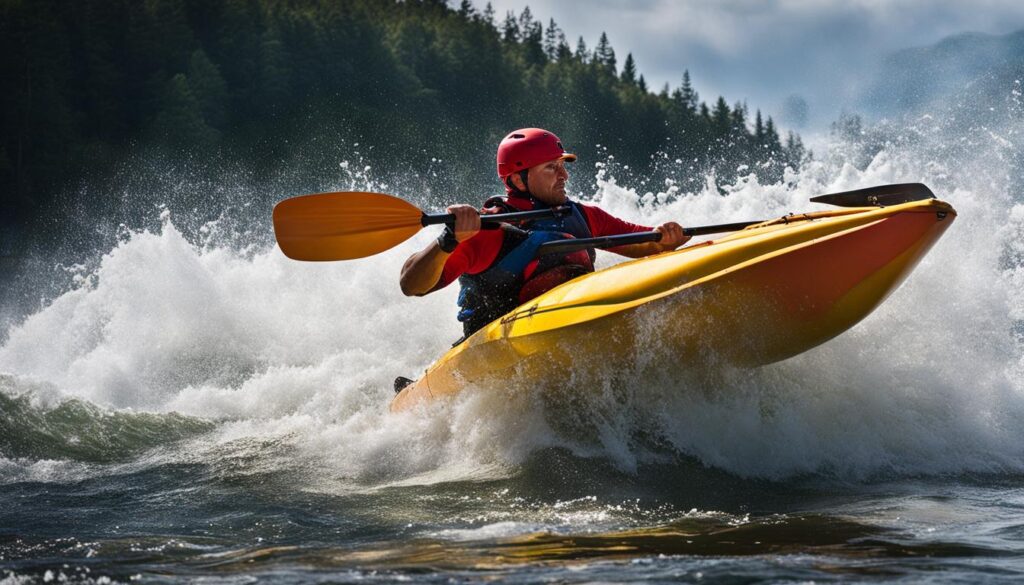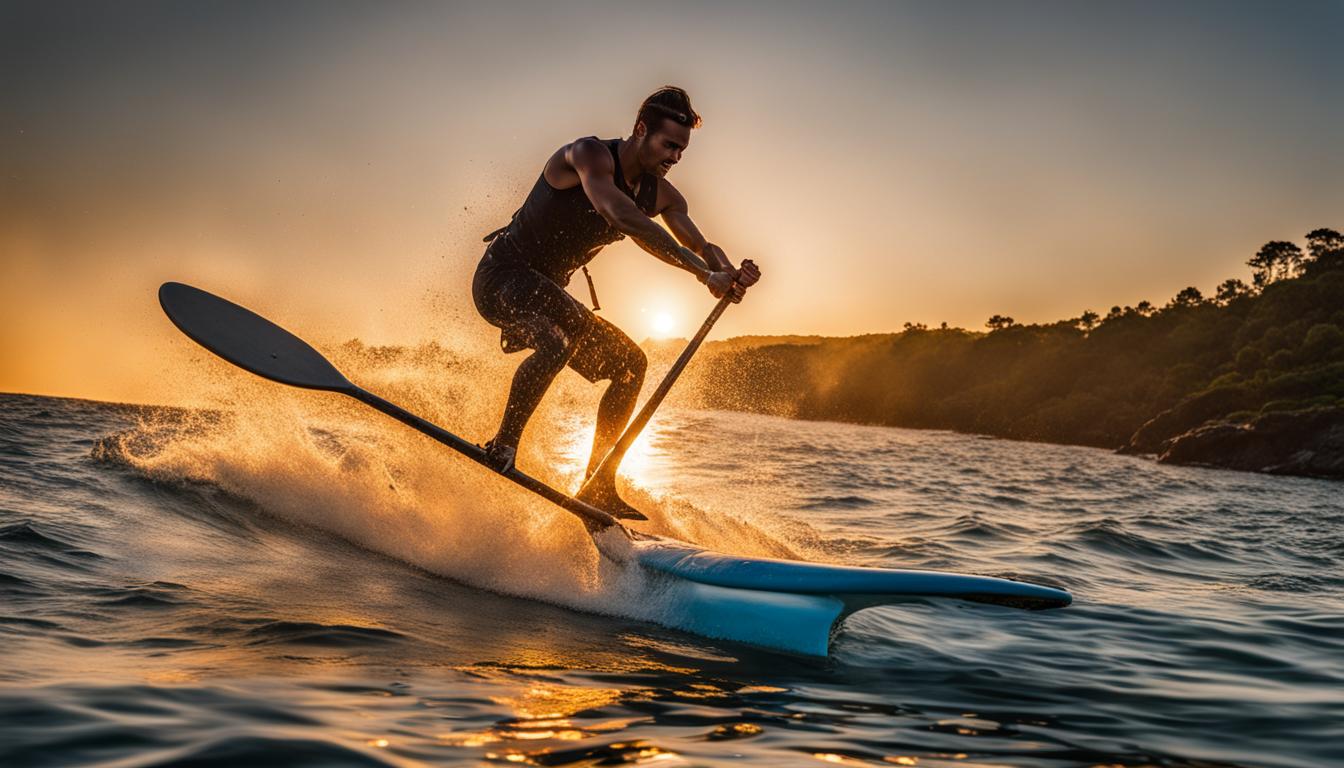Are you looking to take your kayaking skills to the next level? One of the key factors in improving your paddling performance is power. Power is a combination of strength and speed, and it plays a crucial role in fast movement patterns required in kayaking. To enhance your power, incorporating plyometric exercises into your training routine can be highly beneficial.
Plyometrics for kayak power training involves explosive movements that work on both your strength and speed simultaneously. These exercises are designed to improve your ability to generate force quickly, allowing you to paddle with greater efficiency and effectiveness.
In this article, we will explore the importance of power in kayaking, discuss how to train for power specifically in the context of kayaking, and provide you with a list of plyometric exercises that can help you develop and enhance your kayak power.
Key Takeaways:
- Plyometric exercises are essential for developing power in kayakers.
- Power is a combination of strength and speed, crucial for fast movement patterns in kayaking.
- Training at peak power or maximum power output can lead to significant improvements in power.
- Choosing exercises that mimic kayaking movements and target the specific muscles involved is important.
- Incorporating plyometric exercises into your training routine can enhance your paddling performance.
What is Power and Why is it Useful for Kayaking?
Power is the relationship between strength and speed and it determines how fast we can move heavy things. In kayaking, power is crucial as it is a sport that requires fast movement patterns, such as air loops. Training for power is important to generate force quickly. The power curve shows that as the load increases, the power will go up, but there will be a reduction in speed. Finding the balance between force and speed that creates the biggest power development is key. Power training is beneficial for kayakers to improve their paddling performance.
Developing power in kayaking through plyometrics can enhance your paddling performance and overall strength. Plyometrics involve explosive movements that help improve muscular power by training the fast-twitch muscle fibers. Fast-twitch muscle fibers are responsible for generating quick and powerful movements, making them essential for kayakers. By incorporating plyometric exercises into your training routine, you can increase your ability to generate force quickly, resulting in more powerful strokes and improved performance on the water.
Not only does power training in kayaking contribute to better paddling performance, but it also helps prevent injuries. Building power can enhance your ability to maneuver your kayak effectively and handle challenging situations with greater ease. By improving your power, you can react quickly to changes in the water and maintain control over your kayak. This can reduce the risk of accidents and injuries, making power training an essential aspect of kayaking preparation.
The Power Curve in Kayaking
The power curve in kayaking illustrates the relationship between force and speed. As the load increases, the power output increases as well. However, there comes a point where further increasing the load leads to a decrease in speed. The goal is to find the optimal balance between force and speed that maximizes power development. This can be achieved through targeted power training exercises that challenge your muscles to generate force quickly, simulating the demands of kayaking.

Benefits of Power Training in Kayaking
Power training in kayaking offers several benefits that can improve your performance on the water. By developing power, you can generate more force with each stroke, resulting in increased speed and efficiency. This can help you cover greater distances in less time and maintain a faster pace during competition. Power training also enhances your ability to accelerate quickly, allowing you to navigate through challenging water conditions and perform advanced maneuvers with greater control.
Additionally, power training helps improve your overall fitness level by targeting key muscle groups used in kayaking. By engaging in plyometric exercises, you strengthen your lower body, core, and upper body muscles, enhancing your overall strength and stability. This can reduce the risk of muscle imbalances and injuries, leading to a safer and more enjoyable kayaking experience.
Building Explosive Power in Kayaking
When it comes to training for power in kayaking, a combination of strength and speed exercises is key. One popular method is to train at peak power, which is the heaviest load you can move quickly. However, conflicting studies have emerged regarding the effectiveness of training at peak power compared to training at high loads. To maximize power development, it is suggested to focus on training at maximum power output.
Choosing the right sets, reps, and rest periods is crucial for power training. For kayakers, it is important to use a load specific to the sport. In addition to traditional strength training exercises, plyometric routines can be incorporated to build explosive power. Plyometrics involve explosive movements that help improve muscle power through quick, forceful contractions. These exercises typically involve jumping, bounding, and quick explosive movements.
Contrast training, such as French Contrast Training, is another effective method for training power in kayaking. This technique involves alternating between heavy weightlifting exercises and explosive plyometric exercises. By combining heavy strength training movements with plyometric exercises, contrast training helps improve both strength and speed, resulting in increased power output.
Plyometric Exercises for Kayak Power
Improving kayak power is crucial for enhancing your paddling performance. Plyometric exercises, also known as jump training, can help you develop explosive power and increase your strength and speed in the water. These exercises involve dynamic movements that engage multiple muscle groups and improve cardiovascular fitness. Incorporating plyometrics into your training routine can take your kayaking abilities to the next level.
Benefits of Plyometric Exercises
Plyometric exercises are highly effective for improving power and explosiveness in paddling. They mimic the quick and explosive movements required in kayaking, helping to build strength, speed, and coordination. By incorporating plyometrics into your training program, you can:
- Enhance your paddling efficiency and stroke power
- Improve your overall muscular strength and endurance
- Develop better core stability and balance
Now let’s take a look at some plyometric exercises that can specifically target the muscles used in kayaking:
| Exercise | Description |
|---|---|
| Dumbbell Squat and Press | This exercise targets your lower body and shoulders. Start by holding a dumbbell in each hand at shoulder height, with your feet shoulder-width apart. Squat down, keeping your back straight, and then explosively push up while simultaneously pressing the dumbbells overhead. Repeat for several reps. |
| Bent-Over Row | This exercise works your back, shoulders, and arms. Hold a dumbbell in each hand, hinge forward at the hips, and keep your back straight. Pull the dumbbells up towards your chest, squeezing your shoulder blades together. Lower the dumbbells back down and repeat. |
| Book Grab | This exercise targets your forearm muscles, which are essential for gripping and manipulating the paddle. Hold a closed book with both hands and squeeze it as tightly as possible for about 10 seconds. Relax and repeat several times. |
| Planks | Planks are a great core exercise that engage multiple muscle groups, including your abs, back, and shoulders. Start in a push-up position, resting your forearms on the ground. Keep your body in a straight line and hold this position for as long as you can. |
By incorporating these plyometric exercises into your training routine, you can build explosive power and improve your performance on the water. Remember to always warm up properly before attempting plyometrics, and consult with a professional trainer if you’re new to this type of training. Stay consistent, be patient, and enjoy the benefits of increased paddling power!
How to Train for Kayaking: Final Thoughts
Incorporating land-based workouts into your training program can have a significant impact on your kayaking performance. By focusing on strength, core stability, and cardio, you can improve your paddling efficiency, power, and endurance. Training exercises like planks, dumbbell squat and press, high and low wood chops, bent-over rows, and kettlebell swings can target specific muscle groups and improve overall performance. It’s important to choose exercises that mimic the movements used in kayaking and focus on the specific muscles involved in paddling. With a well-planned training program, you can enhance your kayaking abilities and enjoy the sport to the fullest.
Increasing kayak stroke power is a goal for many paddlers looking to improve their performance. Incorporating plyometric exercises into your training routine can help you achieve this goal. Plyometrics involve explosive movements that engage the fast-twitch muscle fibers, which are essential for generating power. By incorporating exercises such as box jumps, medicine ball slams, and depth jumps, you can develop the explosive power needed for strong and efficient paddle strokes. Remember to start slowly and gradually increase the intensity and duration of your plyometric workouts to avoid injury.

Alongside plyometric exercises, it’s important to also focus on strength training to build the necessary muscle power for kayaking. Compound exercises like squats, deadlifts, and bench presses are great for developing overall strength and stability. Additionally, incorporating exercises that target the muscles used during kayaking, such as the lats, shoulders, and core, can further enhance your stroke power. Don’t forget to include a variety of exercises that work different muscle groups to ensure balanced development and reduce the risk of overuse injuries.
Conclusion
Training for power in kayaking is crucial for improving your paddling performance. Power is a combination of both strength and speed, and it requires training both elements. While there is conflicting research on the most effective type of training for power, a program that incorporates both strength and speed is generally recommended.
When it comes to power training, many experts suggest training at peak power, which is the heaviest load you can still move quickly. However, there are differing opinions on the effectiveness of training at peak power compared to training at high loads. It’s important to consider your own preferences and goals when deciding which approach to take.
Plyometric exercises can be highly beneficial for developing kayak power. Exercises such as dumbbell squat and press, high and low wood chops, bent-over rows, and kettlebell swings target specific muscle groups and improve overall performance. Incorporating these exercises into a well-rounded training program can lead to enhanced paddling performance and enjoyment in the water.
By focusing on power development and incorporating plyometric exercises into your training routine, you can increase your paddling performance and take your kayaking skills to the next level. So, get out there, train smart, and enjoy the thrill of paddling with improved power!
FAQ
What is power?
Power is a combination of strength and speed. It determines how fast we can move heavy things.
Why is power important for kayaking?
Power is crucial for kayaking as it requires fast movement patterns. Generating force quickly is essential for paddling performance.
How can I train for power in kayaking?
Training for power in kayaking can be done by training both strength and speed. It is often recommended to train at peak power, which is the heaviest load you can still move quickly. However, there are conflicting studies on the effectiveness of training at peak power compared to training at high loads.
What are some plyometric exercises for kayak power?
Some plyometric exercises that can help improve kayak power include dumbbell squat and press, high and low wood chops, bent-over rows, and kettlebell swings.
How can I incorporate land-based workouts into my kayaking training?
By focusing on strength, core stability, and cardio, you can improve your paddling efficiency, power, and endurance. Exercises like planks, dumbbell squat and press, high and low wood chops, bent-over rows, and kettlebell swings can target specific muscle groups and improve overall performance.
How can training for power enhance my kayaking abilities?
Training for power in kayaking can lead to improved paddling performance, increased power and endurance, and overall enjoyment of the sport.





